Menu
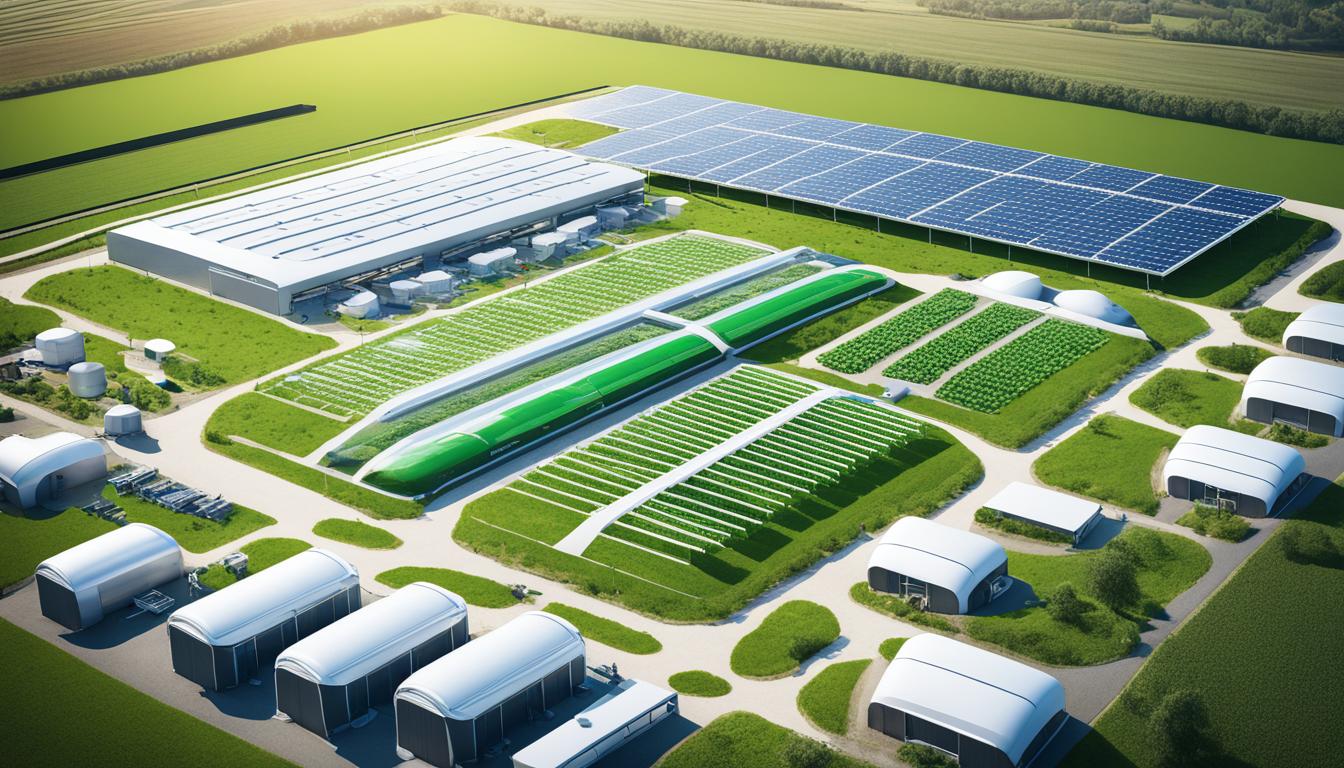
Did you know that using advanced technologies in farming has significantly boosted livestock activity by 91%? This shows how smart farming is changing the game. It uses tools like sensors, artificial intelligence, and IoT gadgets. With these, traditional farming methods are getting a high-tech makeover.
Using these tools, farmers can keep a close eye on animal health. They can also automate the feeding process. Plus, they get to study data in depth. This helps them make smarter choices. As a result, managing livestock gets better. The quality of products from these animals improves too.
Moreover, smart farming is kinder to our planet. It helps use land and water more wisely. It also encourages farming in ways that are better for the environment.
Studies by Roberts D.P. et al. (2021) and the European Commission (Research*eu, 2017) confirm the importance of smart farming. They highlight its role in keeping diseases at bay. In a way, smart livestock farming is the heart of a modern farming revolution. It helps us farm efficiently and take care of our planet while meeting the world’s hunger needs.
Digitalisation has transformed how farmers manage their animals. Technologies like sensors and IoT make farming more efficient and precise. These advancements boost productivity, improve animal welfare, and enhance farm operations.
Sensors and IoT devices allow for real-time monitoring in livestock management. They track things like temperature, movement, and hormone levels. This helps with animal health and even milk production.
Right now, 12% of dairy farms use robots for different tasks. This number is set to increase to 20% in the next five years.
Digitalisation is quickly becoming a key part of running a farm. Sensors help farmers by alerting them to any issues. This means they can react quickly, making the farm more efficient.
Using data analysis improves how farms are run. This process turns data from sensors into useful information. It helps make decisions that better manage the farm, like choosing the right cattle to breed.
The livestock industry in the United States is worth more than $30 billion a year. This attracts a lot of investor interest. It shows why using data analysis is crucial for successful livestock management.
The table below shows how technology is becoming more important in farming:
| Technology | Current Adoption | Projected Growth |
|---|---|---|
| Robots for Dairy Tasks | 12% | 20% in 5 years |
| Sensors for Monitoring | Real-time insights | Expanding utilisation |
| Data Analysis Tools | Enhanced decisions | Greater precision |
is key to changing the industry for the better. It boosts productivity, helps make better decisions, and advances how farms are managed.
Improving animal health and welfare is key in modern farming. Advanced tech helps keep animals well, and happy. This leads to more work from animals and better farming that’s good for the planet.
Using technology, we can find out when animals are sick early. This stops illnesses from spreading and cuts down on deaths. It is good for the farm’s money and makes us treat animals better.
Systems that watch over animal health are very important. They have cameras and sensors to check on how the animals move and behave. This helps spot if they are sick or hurt, so we can help them quickly.
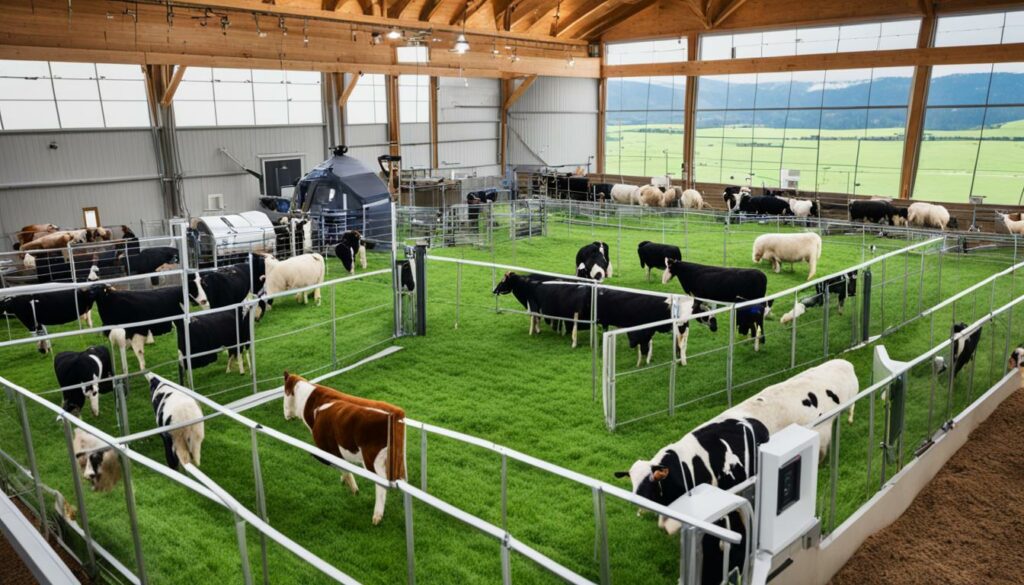
We see how well these new ways work in research:
| Key Technology | Benefit | Example Applications |
|---|---|---|
| Sensors | Improved precision in monitoring | Real-time health metrics, environmental variables |
| Data Analysis & Machine Learning | Enhanced feed composition and health detection | Early disease detection, optimized nutrition |
| Automated Systems | Timely medical intervention | Posture monitoring, behavioural analysis |
235 research papers were looked at, but 33 were left out. The ones looked at showed how watching animal health is crucial. It makes farms better for the animals and the work they do.
Innovative feeding systems are at the forefront of smart farming. They use sensor technology and automation to bring precision to animal nutrition. These smart feeding systems improve how efficiently livestock is produced. They also make animals healthier, more productive, and increase profits.
High-accuracy smart feeding systems have many benefits. They allow farmers to watch feed and water intake closely. This ensures animals get a balanced diet. By monitoring this, farmers can make the animals’ diets more efficient. This means less food is wasted and fewer negative effects on the environment occur.
Automated livestock nutrition is growing. Currently, 12% of dairy farms use robotics, and this is expected to reach 20% in five years. More than 200 studies show that these systems help animals grow better and be more productive.
“Smart livestock production leverages technology to enhance animal health, nutrition, monitoring, management, and marketing, resulting in various economic and social benefits.”
Using graphs to manage food enhances system benefits. Data analysis and machine learning also help. They boost productivity, cut labour costs, and increase profits. With the United States’ livestock market worth over $30 billion a year, interest is high in these methods.
| Attribute | Impact of Smart Feeding Systems |
|---|---|
| Animal Health | Improved due to optimised nutrition |
| Productivity | Increased through precise feed management |
| Profitability | Enhanced by reducing waste and labour costs |
| Environmental Impact | Minimised by reducing feed waste |
Companies like Cainthus are leading in this technology. They use computer vision and artificial intelligence to watch cows all day. This ensures their well-being is taken care of and their productivity is high. Custom feeding plans are created for each animal to improve the food they get.
To sum up, smart feeding systems and automated livestock nutrition are crucial. They are key to making livestock farming more sustainable and profitable.
Sustainable farming is key in today’s agriculture. It helps reduce the bad effects of farming on the environment. It makes our food safe and keeps our surroundings better. This method goes hand in hand with the worldwide push for sustainable farming. Its goal is to offer safe and top-quality food while keeping our planet healthy.

Livestock farming releases a lot of greenhouse gases. It makes up 14.5% of all emissions. We can lower this by farming in a better way. This includes feeding animals only what they need and managing their waste well. In places like Argentina and Vietnam, this has proven to fight climate change and manage the land better.
Farming animals uses a big chunk of the Earth’s farmable land and water. But, new tech helps us do it smarter. Devices like GPS and sensors keep track of animals’ health and growth. This helps farmers use less feed and water, cutting down on waste. In Denmark, for example, they use special tags to make feeding more efficient. This shows how we can save a lot of resources.
| Key Area | Impact |
|---|---|
| Environmental Impact | 14.5% of global emissions from livestock farming |
| Global Value | 40% contribution to agricultural output value |
| Resource Usage | One-third of arable land, 8% of water resources |
| Livelihoods Supported | 1.3 billion people globally |
Precision livestock farming is changing agriculture for the better. It uses advanced technology to boost both productivity and animal health. This way of farming also supports sustainable practices.
Improving feed quality is crucial in precision farming. Automated systems allow us to adjust diets for each animal’s needs. This means healthier animals and less food thrown away.
It uses sensors to track how much animals eat. This ensures food is used wisely, saving resources.
Automated milking changes how we look at dairy farming. It makes milking more constant and efficient, which betters the milk and costs less in labour. Such systems are a step towards better and more profitable farms.
The mix of automated feeding and milking is great for the animals and the business. It offers a complete solution for farm management.
As more farms turn to precision methods, tech integration becomes critical. It boosts farm output and reduces environmental impact. Modern systems are key to feeding the world in a smart and green way.
| Key Benefits | Details |
|---|---|
| Feed Quality Optimisation | Tailored diets improve health and reduce waste, ensuring efficient resource usage |
| Automated Milking Systems | Enhance efficiency, improve milk quality, and reduce labour costs |
| Environmental Sustainability | Minimises waste and resources, contributing to sustainable farming |
Today, automated livestock monitoring is a big step forward for farmers. With the need for meat and eggs going up, keeping an eye on animals is crucial. This new tech lets farmers watch their livestock from afar and keep up with the demands.
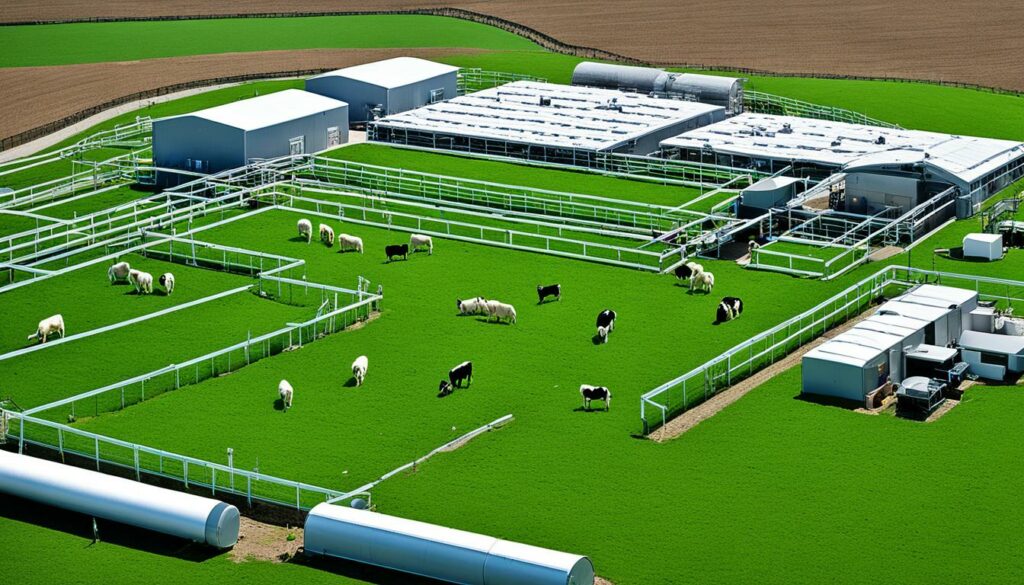
Farms now have tools that watch animals’ health 24/7. These tools include chips, cameras, and microphones. Thanks to companies like Fancom, farmers in many countries can use these advanced systems. Fancom is devoted to making sure their tech is always getting better, with one of every five employees working on new ideas.
Getting data from the farm right away is game-changing. Sensors pick up data immediately, which helps farmers respond quickly. This early data can even spot sick animals before they show symptoms. It’s thanks to Precision Livestock Farming that farmers can keep an eye on their herds all day. This makes for smart decisions when they’re needed most.
“The application of Precision Livestock Farming technologies can help farmers allocate their time more efficiently, focusing on individual animals that require attention or preventive measures.” – Industry Expert
Automated monitoring is key for dealing with issues like a lack of workers, caring for animals, and keeping costs down. Now, with instant data, farmers can meet their animals’ needs better. This improves their farm’s success and the environment in the long run.
In agriculture, tech for livestock is key for making things better. Robotic and drone tech boost farm work. They help us work smarter and look after animals well.
Using drones has changed farming a lot. Drones help watch over animals and check crops. They give farmers clear pictures from above. This helps keep animals healthy and farms running well.
Robots are stepping up in farming too. Now, 12% of dairy farms use them, and this might reach 20% soon. Robots milk cows, feed animals, and clean stables. This cuts costs and makes work smoother.
Companies like Cainthus and Faromatics lead this. They use the latest in technology to watch how animals act. This new way helps farming be more successful with the use of good data.
There are over nine million dairy cows in the USA. They help make a market worth over $30 billion every year. Tech has made managing animals easier, boosting farm profits.
For example, BinSentry from Canada tracks feed bins. This fixes a big issue in feeding animals. Rex Animal Health helps manage animal health better with data. These new tools are making a big difference.
To improve, we need to focus more on the animals. They should live more naturally with the help of robots. This makes for happier animals and more productive farms. The future of farming looks bright thanks to these changes.
Smart livestock farming combines new tech with old methods. It helps make farming more effective and green. Using smart systems, we keep an eye on the health of our animals all the time. This leads to better farming results and happier animals.
Top tech like trackers and sound checks find animal health problems early. This means less need for medicine and fewer animals getting sick. It’s all about making sure the animals are as healthy as they can be.
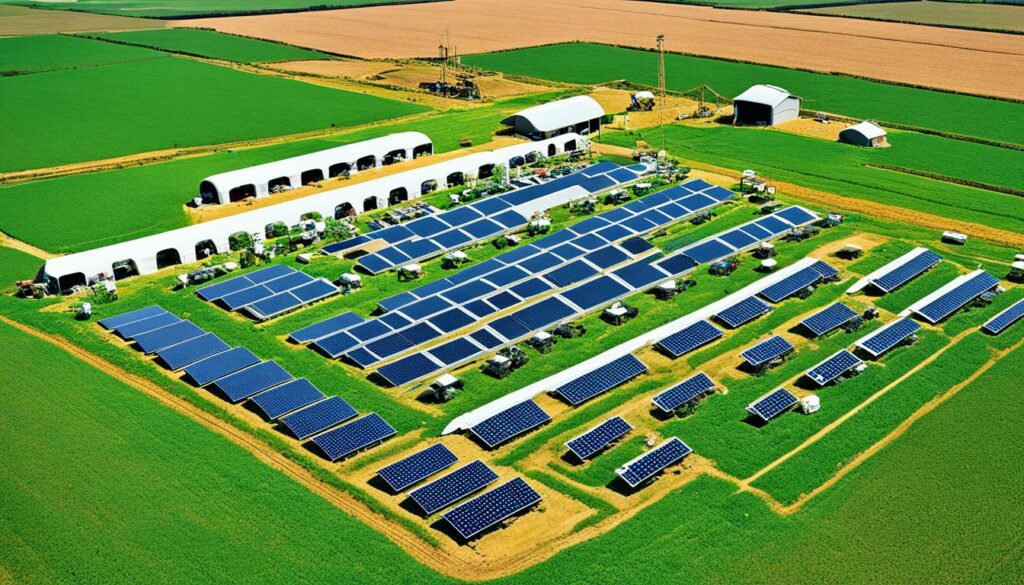
Facts show that using precise farming makes less mess in the environment. It’s especially great for making sure dairy cows stay well. They can catch and fix problems quickly using cameras and special mats.
Systems for pigs and chicken spot health issues too. Like, they can tell when a pig’s tail has been bitten. Or they notice if a bird is sick by looking at how it stands.
Now, let’s talk about how smart farming helps the economy. Farming makes a big chunk of the money in the world, about 40%. So, making it smarter and better with tech is a big deal.
Detecting diseases early stops them from spreading and hurting the economy. This is super important, with the amount of meat people need going up each year.
Smart farming also helps where there aren’t enough people to work, like in the US. It lets farmers do more without as much effort. They can use robots to milk cows or feed animals. This makes farming greener and easier on the planet.
In the end, using tech in farming not only makes things better for farmers and animals. It also helps the Earth. So, it’s a win-win for everyone involved.
Using smart farming tech brings big economic wins to the field. It joins new data tech with farming and boosts both saving and making money. This change makes farms more efficient and able to compete better in the market.
Smart farming cuts down on costs for production by a lot. For example, GPS collars on cows mean farmers can know exactly where their cows are in the field, without needing more people to watch them. The Monarch Tractor’s MK-V helps with this too, by auto-generating reports that look at saving fuel, cutting down on pollution, and how much they work on their own. The U.S. Department of Energy also helps farmers by giving out special deals on some smart farming tools. This all makes it easier for farmers to upgrade their technology.
Smart farming boosts how much food we can grow by a lot. For example, using special solar tech for glass in greenhouses and controlling the inside perfectly helps grow more food. Adding GPS to planting and harvesting makes fewer mistakes and grows more crops. This helps farmers make more money, increasing how well their business does.
| Technology | Benefit | Impact on Productivity |
|---|---|---|
| GPS-enabled Collars | Reduces labour costs | Efficient herd management |
| DSSC for Greenhouses | Optimises resource use | Higher crop yields |
| Monarch Tractor’s MK-V | Automates tasks | Increased operational efficiency |
Blockchain is changing how we track livestock and ensure food safety. It makes the journey from farm to plate more transparent. This, in turn, helps build trust with consumers.
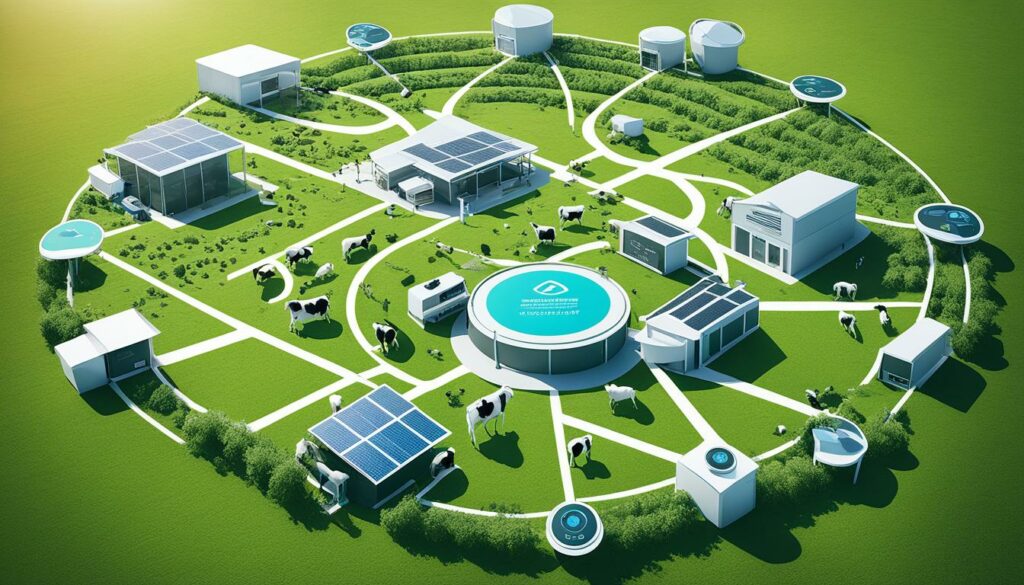
Blockchain technology in agriculture shines a light on every step of farming. It tackles issues like doubts about meat quality and the push for better supply chain tracking. With blockchain, every animal’s life is recorded. This gives clear details on where the animal came from, its health, and if it had any antibiotics.
All this data is kept safe from changes through cryptography. This technology prevents information tampering. As a result, food recalls and contamination risks drop. Food safety rises, and shoppers feel more confident about what they eat.
Blockchain is also turning around how we manage supply chains. It fast-tracks and checks products along the way, which helps meet quality rules. The blockchain network is solid yet flexible, able to handle problems without failing.
With these clear and secure systems, farmers can reach new buyers. It makes the food industry stronger and safer. This is crucial for meats and other farm foods that need strict safety checks.
| Benefits | Impact |
|---|---|
| End-to-end traceability | Enhanced food safety and consumer trust |
| Real-time data tracking | Improved supply chain management |
| Tamper-proof records | Data integrity and reduced fraud |
| Transparency | Stronger brand reputation and market opportunities |
| Efficient audit trails | Compliance with quality standards |
Smart farming has many benefits, but it’s hard to start. The big costs and getting the technology are two main issues. Not everyone can afford the latest tech, like AI and IoT, especially small farmers.
Starting smart farming means a lot of money goes out. Buying things like the MK-V electric tractor can save money later, but first, you need a lot of cash. Also, not all farmers can get these new tools, especially those far from cities.
| Factor | Impact | Example |
|---|---|---|
| High Initial Cost | Financial strain on small-scale farmers | MK-V electric tractor |
| Lack of Accessibility | Inconsistent technology adoption | Remote area farmers’ challenges |
Managing the huge amount of data from smart farming is a big issue. Getting good internet in rural areas for the data is hard. Plus, dealing with all the data needs a lot of tech skills or money.
For smart farming to work, we need good systems to handle all the data. We must also make sure the data is safe and kept private from hackers.
In the end, smart farming is great but hard because of the costs and getting the right tools. Solving these problems will help more farmers use smart farming successfully.
Smart livestock farming opens new doors for farmers in the changing agricultural world. They can use smart tech to upgrade their methods, making farming more efficient and eco-friendly. This move is key to meeting growing food needs, staying green, and making money.
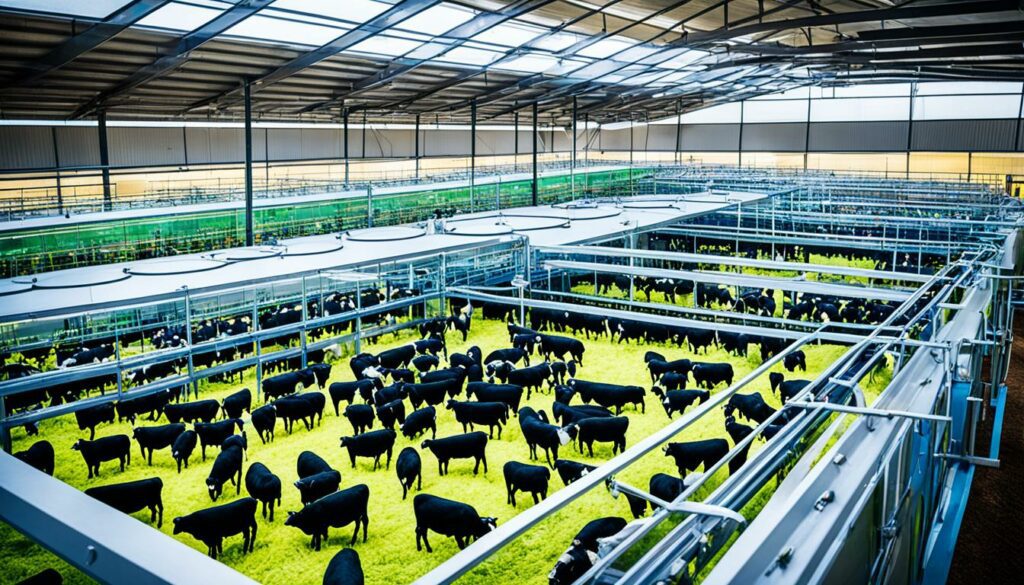
Adapting means using the latest tech to make farming better. A review found that modern livestock farming uses tech for healthier animals, better nutrition, and smarter farm management and marketing. This high-tech approach makes farming more sustainable by using resources wisely, not wasting them. This also helps the farm become more productive.
Data from recent studies shows how sensors in feeding systems keep track of what the animals eat and drink. This keeps their diet balanced and makes the farm run smoother. Such tech helps farmers take better care of their animals, reduce harm to the environment, and run their farms more efficiently.
Using smart tech in farming can make farms more profitable. Precision feeding and automatic tasks can help farmers produce more without stressing their animals. Automated systems make sure the animals get the right food at the right time, saving on resources. This improves the farm’s productivity and how it uses resources.
These smart farming methods also cut down harm on the environment. By better managing food and checking the farm’s conditions, farmers can reduce waste and the carbon footprint. These green practices mean farms can satisfy customer demands for eco-products and be more profitable in the long run.
In the end, using smart livestock farming methods can boost profit and eco-friendliness. It marks a big step forward in making farming both efficient and good for the planet.
In the future, smart farming tech will transform agriculture. These tools, using AI and machine learning, boost efficiency and help farms be more sustainable. With the world’s population growing to 9.8 billion by 2050, smart solutions are needed urgently.
AI and machine learning are changing farming dramatically. They let farmers make real-time decisions, increasing their productivity. For instance, the MK-V electric tractor cuts costs by being more efficient. These technologies also make it easier to plan for the future by using a lot of data.
Exciting new tools are changing how farming works. Things like tracking farm animals, advanced greenhouses, and GPS for moving goods make farming more efficient. Drones, on the ground and in the air, do jobs like checking crop health and watching out for pests. This helps farmers make better choices, like choosing organic farming.
But, using these advanced tools can be hard. Farmers might not be used to them, they could be expensive, and there’s the issue of keeping data safe. Despite these challenges, we’re moving towards a new farming revolution. This future farming will use precision tools, big data, and robots, making farming smarter and more sustainable.
Smart livestock farming uses advanced tools like sensors and artificial intelligence. It upgrades old farming methods. This leads to better livestock care and more crops.
Sensors and IoT work in real time to check on animals. They measure things like temperature and motion. This improves how farms are run.
Data tools help sort the info from sensors. This helps run the farm better. It also makes sure animals are well.
Technology spots diseases early. This is done by checking the animals’ health every day. It means the animals get the best care.
These systems watch over animal health all the time. They use lots of sensors and AI. If something’s not right, the farmer gets a quick alert.
New feeding systems use sensors and automation. They help feed animals the right amount. This makes them grow well and reduces waste.
It’s good for the environment by feeding animals only what they need. Less waste is produced. This makes farming kinder to the Earth.
Precision farming picks the best food for each animal. It means they’re healthier and produce more. This is done with modern systems.
Automatic systems collect data without the farmer there. They give real-time information. This helps make sure the animals are looked after well.
Drones help keep an eye on the animals and crops. This makes farming more efficient. They’re like a farmer’s helpful eye in the sky.
Smart farming saves money and time. It makes farms more productive. It needs fewer people to work. This leads to better use of resources and more crops.
Blockchain tracks animal products from farm to store. It makes sure food info is clear and trusted. Shoppers know where their food comes from.
Using smart farming can be expensive. It might also be hard to get the tools. Plus, handling a lot of data and keeping devices connected is a challenge.
Smart farming helps farmers grow. It makes their work more sustainable. It meets what shoppers want. It also makes farms more productive and efficient.
AI and machine learning will grow in farming. New tech will make farming smarter and greener. It will reduce waste and help the Earth.